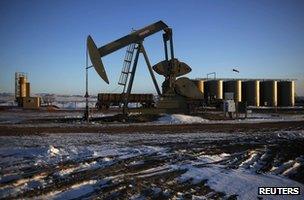Oklahoma earthquake linked to oil extraction wastewater
- Published

The quake's cause was hotly debated from the day that it struck Oklahoma
Scientists have linked the underground injection of oil-drilling wastewater to a magnitude-5.7 earthquake in 2011 that struck the US state of Oklahoma.
Wastewater injection from drilling operations has been linked to seismic events in the past, but these have typically been much smaller quakes.
They also have tended to occur in the first weeks or months of injection.
The study in Geology, external suggests that "induced seismicity" can occur years after wastewater injection begins.
Wastewater was first injected into Oklahoma's Wilzetta oilfields, near the town of Prague, some 18 years prior to the November 2011 series of quakes, external that included three of magnitude 5 or greater.
The new study adds to an increasing body of evidence that the injection of wastewater is correlated to an increase in seismic events.
A comprehensive review, external in 2012 by the US' National Academy of Sciences found that "injection for disposal of waste water derived from energy technologies into the subsurface does pose some risk for induced seismicity".
However, the report said the number of such documented events over several decades was small compared to the overall number of operations carried out.
In April 2012, a study by scientists at the US Geological Survey, external of the interior of the US found that events of magnitude 3 or greater had "abruptly increased in 2009" from 1.2 per year in the previous 50 years to more than 25 per year - although a number of gas and oil extraction methods may be implicated in the rise.
'Unexpectedly large'
But the authors of the new study focus on the significantly larger and delayed events in Prague, which they wrote "necessitate reconsideration of the maximum possible size of injection-induced earthquakes, and of the time scale considered diagnostic of induced seismicity".
Study co-author Geoffrey Abers of Columbia University said that "there's something important about getting unexpectedly large earthquakes out of small systems that we have discovered here, " adding that "the risk of humans inducing large earthquakes from even small injection activities is probably higher" than had been believed.

An increase in seismic events has been noted across the US "midcontinent"
But seismologist Austin Holland of the Oklahoma Geological Survey said while the study showed a potential link between the earthquake and wastewater injection, "it is still the opinion of those at the Oklahoma Geological Survey that these earthquakes could be naturally occurring".
"There remain many open questions, and more scientific investigations are underway on this sequence of earthquakes and many others within the state of Oklahoma," he said.
The topic is particularly relevant to the hydraulic fracturing or "fracking" debate.
In fracking, water, sand and chemicals are injected into petroleum wells in a bid to extract trapped natural gas.
Opponents of the practice say that it risks causing seismic events and contaminating groundwater.
The National Academies report concluded that "the process of hydraulic fracturing a well as presently implemented for shale gas recovery does not pose a high risk for inducing felt seismic events".
But fracking creates wastewater that is often injected underground just as in conventional drilling, a practice that has been implicated in seismic events, external as well, but that is currently prohibited by EU legislation, external.
The topic remains hotly debated in the scientific literature, and between lobbyists and policy-makers, particularly in the UK.
Links between fracking in Blackpool and tremors in the region led to a government ban on the practice, which was lifted at the end of December 2012.
Correction 27 March 2013: An earlier version of this story incorrectly stated that the wastewater injected was from hydraulic fracturing - in fact, the wastewater implicated was from conventional oil drilling.
- Published17 February 2012